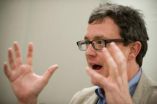(Press-News.org) The Great Recession and the currently tepid economic recovery swelled the ranks of American households confronting hunger and food insecurity by 30 percent. In 2010 48.8 million Americans lived in food insecure households, meaning they were hungry or faced food insecurity at some point during the year. That's 12 million more people than faced hunger in 2007, before the recession, and represents 16.1 percent of the U.S. population.
Yet hunger is not readily seen in America. We see neither newscasts showing small American children with distended bellies nor legions of thin, frail people lined up at soup kitchens. That's primarily because the expansion of the critical federal nutrition assistance program, the Supplemental Nutrition Assistance Program, helped many families meet some of their household food needs.
But in spite of the increase in Supplemental Nutrition Assistance Program funding, many families still have to make tough choices between a meal and paying for other basic necessities. In 2010 nearly half of the households seeking emergency food assistance reported having to choose between paying for utilities or heating fuel and food. Nearly 40 percent said they had to choose between paying for rent or a mortgage and food. More than a third reported having to choose between their medical bills and food.
What's more, the research in this paper shows that hunger costs our nation at least $167.5 billion due to the combination of lost economic productivity per year, more expensive public education because of the rising costs of poor education outcomes, avoidable health care costs, and the cost of charity to keep families fed. This $167.5 billion does not include the cost of the Supplemental Nutrition Assistance Program and the other key federal nutrition programs, which run at about $94 billion a year.
We call this $167.5 billion America's hunger bill. In 2010 it cost every citizen $542 due to the far-reaching consequences of hunger in our nation. At the household level the hunger bill came to at least $1,410 in 2010. And because our $167.5 billion estimate is based on a cautious methodology, the actual cost of hunger and food insecurity to our nation is probably higher.
This report also estimates the state-by-state impact of the rising hunger bill from 2007 through 2010. Fifteen states experienced a nearly 40 percent increase in their hunger bill compared to the national increase of 33.4 percent. The sharpest increases in the cost of hunger are estimated to have occurred in Florida (61.9 percent), California (47.2 percent), and Maryland (44.2 percent).
Our research in this report builds upon and updates a 2007 report principally sponsored by the Sodexo Foundation and written by Brandeis University Professor Donald Shepard, the principal author of this report; Larry Brown, who was then on the faculty at of the Harvard School of Public Health; and Timothy Martin and John Orwat from Brandeis University. That initial report, "The Economic Costs of Domestic Hunger," was the first to calculate the direct and indirect cost of adverse health, education, and economic productivity outcomes associated with hunger. This study extends the 2007 study, examining the recession's impact on hunger and the societal costs to our nation and to each of the 50 states in 2007 and 2010. It also provides the first estimate of how much hunger contributes to the cost of special education, which we found to be at least $6.4 billion in 2010.
The 2007 report estimated America's hunger bill to be $90 billion in 2005, sharply lower than the $167.5 billion bill in 2010. In the pages that follow, we will describe how we calculated our nation's annual hunger bill. We then argue that any policy solutions to address the consequences of hunger in America should consider these economic calculations. The reason: We believe our procedures for expressing the consequences of this social problem in economic terms help policymakers gauge the magnitude of the problem and the economic benefits of potential solutions.
In this paper we do not make specific policy proposals beyond adopting our methodology for calculating hunger in America, but we do point out that expanding the Supplemental Nutrition Assistance Program to all food insecure households could cost about $83 billion a year. While we do not recommend this approach, we note that nonetheless it would cost the nation much less than the most recent hunger bill in 2010 of $167.5 billion.
There are other policy approaches that also could achieve sustained reduction in hunger and food insecurity—approaches that rely on a mix of federal policies to boost the wages of the lowest-wage earners, increase access to full-time employment, and modestly expand federal nutrition programs. These policies are consistent with the variables used to allocate federal nutrition funding to states under The Emergency Food Assistance Program. In using the state's poverty and unemployment rates, this program recognizes that improved economic conditions reduce hunger and the need for emergency support.
INFORMATION:
Donald S. Shepard is a professor at the Heller School, Brandeis University, in Waltham, Massachusetts. Elizabeth Setren is an assistant economist at the Federal Reserve Bank of New York. Donna Cooper is a Senior Fellow with the Center for American Progress.
END
Why are some places more prone to bribery and corruption than others? Part of the answer seems to be the level of collective feeling in a society, according to research by Pankaj Aggarwal, University of Toronto Scarborough (UTSC) professor of marketing in the Department of Management, and Nina Mazar, University of Toronto professor of marketing.
Aggarwal and Mazar discovered that people in more collectivist cultures – in which individuals see themselves as interdependent and as part of a larger society – are more likely to offer bribes than people from more individualistic ...
Before Congress passed a budget deal in early August 2011, President Obama expressed concern in a televised speech that the federal government would be unable to pay Social Security benefits without a long-term agreement on the budget. Others in Washington, including President Obama's budget director Jack Lew and Senate majority leader Harry Reid, disputed the president's assertion, maintaining that Social Security is a self-funding program with a $2.6 trillion trust fund that is capable of funding benefit payments for the next 25 years. How could politicians deliver such ...
Zinc plays a critical role in regulating how neurons communicate with one another, and could affect how memories form and how we learn. The new research, in the current issue of Neuron, was authored by Xiao-an Zhang, now a chemistry professor at the University of Toronto Scarborough (UTSC), and colleagues at MIT and Duke University.
Researchers have been trying to pin down the role of zinc in the brain for more than fifty years, ever since scientists found high concentrations of the chemical in synaptic vesicles, a portion of the neuron that stores neurotransmitters. ...
Miami Beach, Fla. — The prognosis for patients with stage II and III inoperable non-small cell lung cancer (NSCLC) is poor, with only about 15 percent of patients surviving at five years post-treatment for the disease. While new treatment strategies are being intensely studied, timely assessment of their efficacy has proven difficult. In a presentation today, Mitchell Machtay, MD, principal investigator of the ACRIN 6668/RTOG 0235 trial and RTOG deputy chair, reported the that post-treatment F-18 fluorodeoxyglucose-positron emission tomography (FDG-PET) scans show promise ...
EAST LANSING, Mich. -- What makes people great? Popular theorists such as the New Yorker's Malcolm Gladwell and the New York Times' David Brooks argue that intelligence plays a role -- but only up to a point. Beyond that, they say, it's practice, practice, practice.
Zach Hambrick agrees with the practice argument -- imagine where Bill Gates would be if he hadn't honed his programming skills, after all -- but the Michigan State University scientist takes exception to the view that intelligence plays no role in determining excellence.
In a provocative new paper, Hambrick ...
Social Security Commissioner Michael J. Astrue recently announced the expansion of the list of conditions that qualify a benefit applicant for a fast-track application under either the Quick Disability Determination (QDD) or Compassionate Allowances program (CAL). The SSA created the QDD and CAL programs in 2008 to help get disability benefit payments to those who need them most. It is important for those who apply for Social Security disability benefits to be aware of the fast-track process to see if they qualify.
What Conditions Qualify?
The fast-track program initially ...
New data gathered from the latest census and the Center for Disease Control's National Vital Statistics System reveal that states that perform or recognize same-sex marriage have lower divorce rates for all couples compared to states that do not recognize or ban same-sex marriage.
Five of the ten states with the lowest divorce rates are among the eight states that perform or recognize same-sex marriage. In 2009, the divorce rate for these states was 41.2 percent, compared with 50.3 percent in states without same-sex marriage. That rate increases to 53.2 percent if one ...
A University of Colorado Boulder-led team excavating a Maya village in El Salvador buried by a volcanic eruption 1,400 years ago has unexpectedly hit an ancient white road that appears to lead to and from the town, which was frozen in time by a blanket of ash.
The road, known as a "sacbe," is roughly 6 feet across and is made from white volcanic ash from a previous eruption that was packed down and shored up along its edges by residents living there in roughly A.D. 600, said CU-Boulder Professor Payson Sheets, who discovered the buried village known as Ceren near the ...
Atlanta fireplace supplier Craft Stove and Fireplace Center is promoting fire safety with guidance on how to safely enjoy a back yard fire pit. Crisp autumn nights are the perfect time to gather around a warm fire, and these tips will ensure that this pleasant family activity is also a safe one.
"The first stop in practicing fire safety is to take the right precautions," explains Melinda Pulliam, Director of Marketing for Craft Stove and Fireplace Center. "There are many easy steps you can take to minimize safety hazards."
Keep fires small, and ...
Not long ago, geologically speaking, a now-vanished lake covered a huge expanse of today's Canadian prairie. As big as Hudson Bay, the lake was fed by melting glaciers as they receded at the end of the last ice age. At its largest, Glacial Lake Agassiz, as it is known, covered most of the Canadian province of Manitoba, plus a good part of western Ontario. A southern arm straddled the Minnesota-North Dakota border.
Not far from the ancient shore of Lake Agassiz, University of Cincinnati Professor of Geology Thomas Lowell will present a paper about the lake to the Geological ...

